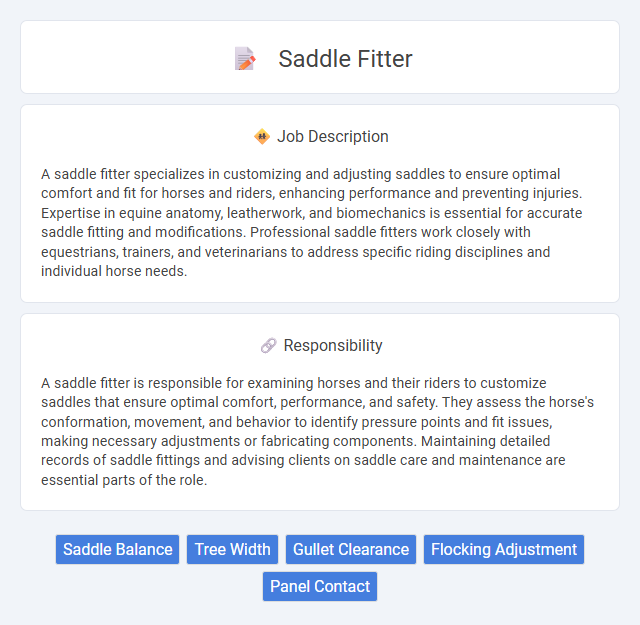
A saddle fitter specializes in customizing and adjusting saddles to ensure optimal comfort and fit for horses and riders, enhancing performance and preventing injuries. Expertise in equine anatomy, leatherwork, and biomechanics is essential for accurate saddle fitting and modifications. Professional saddle fitters work closely with equestrians, trainers, and veterinarians to address specific riding disciplines and individual horse needs.
Individuals with strong observation skills and a keen attention to detail will likely be well-suited for a saddle fitter job, as the role requires precise adjustments to ensure horse and rider comfort. Those with physical stamina and good communication abilities may find it easier to interact with clients and handle the physical demands of fitting saddles. People who struggle with patience or have limited knowledge of equine anatomy might face challenges in this profession.
Qualification
A saddle fitter must possess in-depth knowledge of equine anatomy and biomechanics to ensure proper saddle fit and prevent discomfort or injury to horses. Certification from recognized organizations, such as the Society of Master Saddlers or the International Saddle Fit Professional Association, demonstrates professional competency and commitment to industry standards. Practical experience with various saddle types, combined with strong communication skills to collaborate with riders and veterinarians, is essential for accurate assessment and customization.
Responsibility
A saddle fitter is responsible for examining horses and their riders to customize saddles that ensure optimal comfort, performance, and safety. They assess the horse's conformation, movement, and behavior to identify pressure points and fit issues, making necessary adjustments or fabricating components. Maintaining detailed records of saddle fittings and advising clients on saddle care and maintenance are essential parts of the role.
Benefit
Saddle fitters likely provide significant benefits by improving horse comfort and performance, which can reduce injury risks and enhance riding experience. Their expertise probably leads to better saddle fit, increasing the horse's mobility and rider control. Clients may also experience long-term savings by preventing costly veterinary treatments through proper saddle adjustments.
Challenge
A saddle fitter likely faces the challenge of precisely matching saddle design to individual horse anatomy, which demands detailed knowledge and keen observational skills. The role probably involves identifying subtle fit issues that can affect both horse comfort and rider performance, making problem-solving a critical aspect. Adapting to various horse breeds and rider needs could frequently require specialized expertise and continuous learning.
Career Advancement
Saddle fitters can advance their careers by gaining certifications from recognized equine organizations and developing expertise in equine anatomy and biomechanics. Mastering custom saddle design and repair enhances job prospects and allows for specialization in disciplines like dressage or endurance riding. Experienced saddle fitters often transition into consultancy roles or open their own fitting and repair businesses, capitalizing on their specialized skills and industry reputation.
Key Terms
Saddle Balance
Saddle fitters specialize in achieving precise saddle balance to enhance horse comfort and rider stability, preventing pressure points and uneven weight distribution. They evaluate the saddle's fit through thorough assessment of the horse's back anatomy and movement patterns to ensure optimal alignment. Proper saddle balance improves performance, reduces the risk of injury, and promotes overall equine well-being.
Tree Width
Saddle fitters specialize in adjusting the tree width of saddles to ensure proper alignment with a horse's back, preventing discomfort and injury. Precise measurement of the tree width is crucial for optimal weight distribution and rider stability during equestrian activities. Expert saddle fitters utilize tools like pressure mats and tracing systems to customize the saddle fit based on the horse's conformation and movement.
Gullet Clearance
Saddle fitters ensure optimal gullet clearance to prevent pressure on the horse's spine, promoting comfort and freedom of movement. Proper measurement and adjustment of the saddle's gullet width are crucial to accommodate the horse's withers and back shape. Failure to maintain adequate gullet clearance can lead to pain, behavioral issues, and long-term musculoskeletal damage.
Flocking Adjustment
Saddle fitters specialize in flocking adjustment to customize the saddle's padding, ensuring an even distribution of pressure and optimal comfort for the horse. Precise flocking adjustment prevents sore spots and improves the horse's performance by maintaining proper saddle fit during movement. Skilled saddle fitters use wool or synthetic flocking materials tailored to the horse's back shape and muscle development.
Panel Contact
A saddle fitter specializes in adjusting saddles to optimize panel contact, ensuring even pressure distribution across the horse's back to prevent discomfort and injury. Proper panel contact enhances the saddle's stability and the rider's balance, promoting better performance and horse welfare. Expertise in assessing leather, tree shape, and padding materials is critical for precise fitting tailored to individual horse anatomy.
 kuljobs.com
kuljobs.com